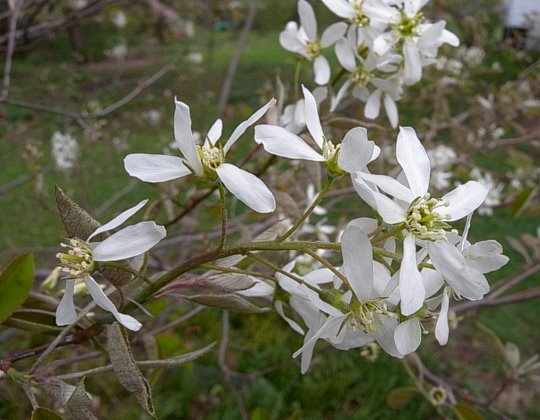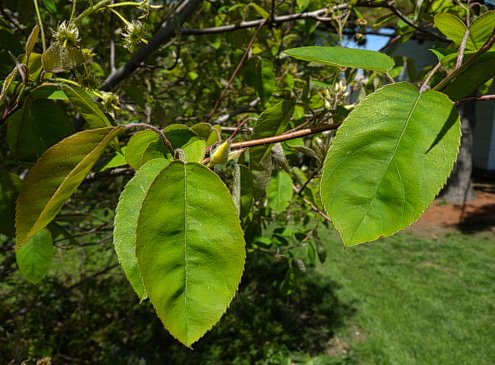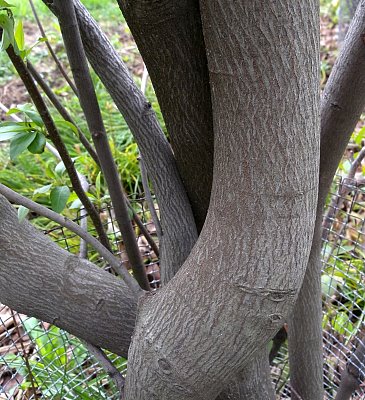
Racemes of 6-14 flowers develop at the tips of shoots; they are 3-7" long. These racemes develop a little before or at the same time as the first emergence of the leaves. Individual flowers are about 1" across, consisting of 5 white narrow petals, a short tubular calyx with 5 teeth, about 20 stamens, and a pistil with a single style. The calyx is light green with woolly hairs; its teeth are much shorter than the petals. The slender pedicels of the flowers are longer toward the base of each raceme (up to 1½" long), becoming shorter toward its tip (up to ¾" long). The blooming period occurs during mid-spring for about 1-2 weeks. The flowers are mildly fragrant. Afterwards, fertile flowers are replaced by small globoid pomes (a type of fruit) about ¼-½" across. At maturity during the summer, these pomes become reddish purple; their flesh is usually rather dry and tasteless, although sometimes it is more soft and sweet. Each pome contains 4-10 seeds that are soft-textured and very small in size. The withered remains of the calyx persist at the bottom of each pome. The root system is woody and branching. Reproduction is by seed.

Cultivation: The preference is full to partial sunlight and moist to dry conditions that are well-drained. Many soil types are tolerated, including those that are loamy, sandy, or rocky.
Range & Habitat: The native Downy Serviceberry is occasional throughout Illinois (see Distribution Map). It the most common species of its genus within the state. Habitats include thinly wooded bluffs, wooded slopes, exposed cliffs, rocky upland woodlands, limestone glades, banks of rivers above the flood zone, and edges of swamps. Fire may be beneficial in maintaining populations of this shrub or tree because it can resprout from the base. It can also colonize newly exposed areas because of the rapid spread of its seeds by birds. Because of its attractive flowers and fruit, Downy Serviceberry is sometimes cultivated.

Faunal Associations: The nectar and pollen of the flowers attract honeybees, Andrenid bees (Andrena spp.) Halictid bees (Halictus spp., Lasioglossum spp.), Syrphid flies, Tachinid flies, and Buprestid beetles (Acmaeodera spp.); see Robertson (1929), MacRae (1991), and Steury (2009). Other insects feed destructively on Downy Serviceberry (Amelanchier arborea). For example, the larvae of some Buprestid beetles bore through the wood (Agrilus vittaticollis, Anthaxia cyanella, Chrysobothris azurea, Chrysobothris chlorocephala, Chrysobothris sexsignata) of this small tree or shrub, while the larvae of some micromoths mine through the leaves (Parornix geminatella, Coptotriche crataegifoliae). Other insects that feed on the wood, foliage, plant sap, and other parts of Amelachnier spp. include the larvae of long-horned beetles, weevils, larvae of gall flies, aphids, armored scales, larvae of sawflies, larvae of moths, and larvae of two butterflies, the Striped Hairstreak (Satyrium liparops strigosum) and Red-spotted Purple (Limenitis arthemis astyanax). The Insect Table provides a more complete list of these insect feeders. Among vertebrate animals, the fruits of Downy Serviceberry are an attractive source of food to the Ruffed Grouse, Hairy Woodpecker, Hermit Thrush, Cedar Waxwing, Baltimore Oriole, and many other birds (see Bird Table). Some mammals also eat the fruit of Amelanchier spp. This includes the White-footed Mouse, Deer Mouse, Gray Squirrel, Fox Squirrel, American Red Squirrel, Eastern Chipmunk, and American Black Bear (Hamilton, 1941; Martin et al., 1951/1961; Wilhelm & Rericha, 2017; Beeman & Pelton, 1980; Romain et al., 2013; Mosnier et al., 2008; Noyce & Coy, 1990). Beavers occasionally gnaw on the bark and wood of these small trees or shrubs when they grow along riverbanks, while White-tailed Deer and American Moose browse on their twigs and leaves (Martin et al., 1951/1961).

Photographic Location: A lawn in Urbana, Illinois.
Comments: This is one of the earliest small trees or shrubs to bloom during the spring. Downy Serviceberry is fairly easy to identify as its young leaves are exceptionally hairy (especially on their undersides). It also differs from some Amelanchier spp. by having fine teeth along its leaf margins that extend all the way to the base. The quality of the fruit is variable, although it is usually inferior to the fruit of another native species, Amelanchier laevis (Smooth Serviceberry). The hard heavy wood has been used to make tool handles in the past.